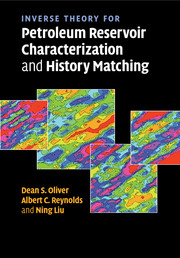Book contents
- Frontmatter
- Contents
- Preface
- 1 Introduction
- 2 Examples of inverse problems
- 3 Estimation for linear inverse problems
- 4 Probability and estimation
- 5 Descriptive geostatistics
- 6 Data
- 7 The maximum a posteriori estimate
- 8 Optimization for nonlinear problems using sensitivities
- 9 Sensitivity coefficients
- 10 Quantifying uncertainty
- 11 Recursive methods
- References
- Index
6 - Data
Published online by Cambridge University Press: 06 January 2010
- Frontmatter
- Contents
- Preface
- 1 Introduction
- 2 Examples of inverse problems
- 3 Estimation for linear inverse problems
- 4 Probability and estimation
- 5 Descriptive geostatistics
- 6 Data
- 7 The maximum a posteriori estimate
- 8 Optimization for nonlinear problems using sensitivities
- 9 Sensitivity coefficients
- 10 Quantifying uncertainty
- 11 Recursive methods
- References
- Index
Summary
To get an explicit solution of a given boundary value problem is in this age of large electronic computers no longer a basic question. The problem can be coded for the machine and the numerical answer obtained. But of what value is the numerical answer if the scientist does not understand the peculiar analytical properties and idiosyncrasies of the given operator? [26]
The main purpose of this chapter is to develop an understanding of the spatial dependence of the sensitivity of measurements to reservoir variables, particularly porosity and permeability. The measurements provide information that improve the quality of predictions of reservoir performance. Different types of measurements are sensitive to model variables in different volumes of reservoir, and have much different complexity. Because the focus in this chapter is on qualitative understanding, for each type of data we present a plot of the sensitivity to values of reservoir properties at various locations, without equations. A straightforward, but inefficient, approach to estimating sensitivities would be to make a small change to the value of permeability or porosity in a region, then compute the change in the theoretical measurement. Vela and McKinley [27] used this approach to estimate sensitivity of pulse test data (a type of interference test between wells) to permeability and porosity.
- Type
- Chapter
- Information
- Publisher: Cambridge University PressPrint publication year: 2008

